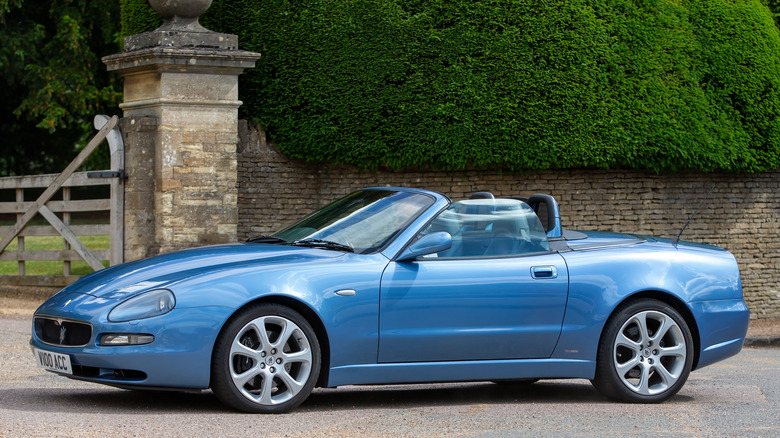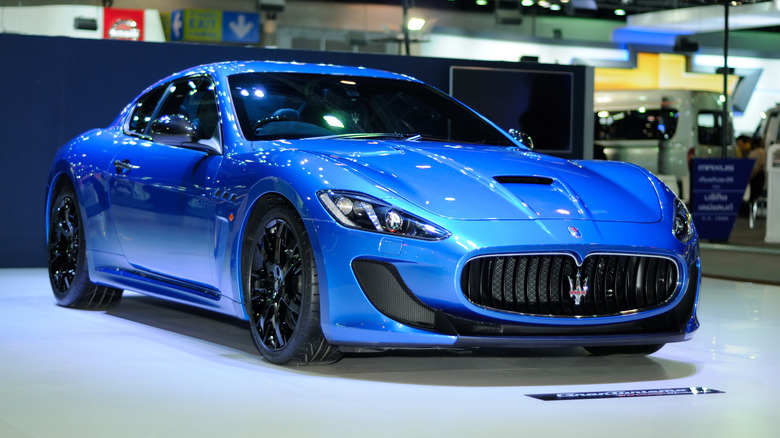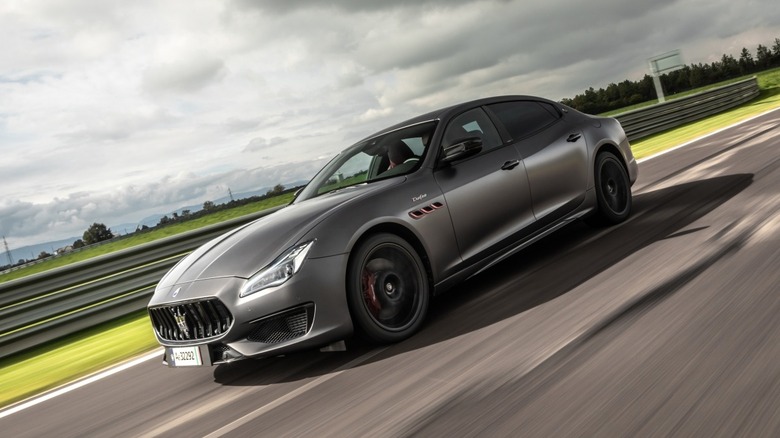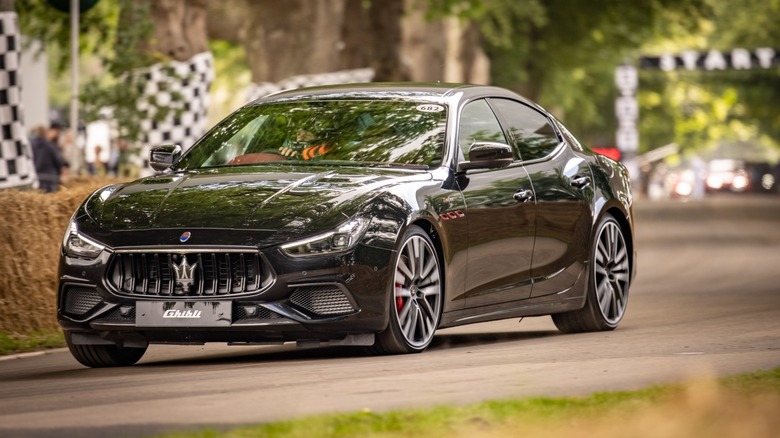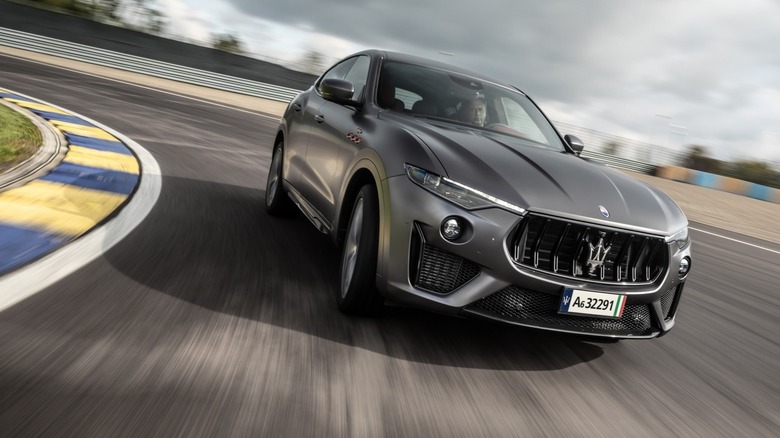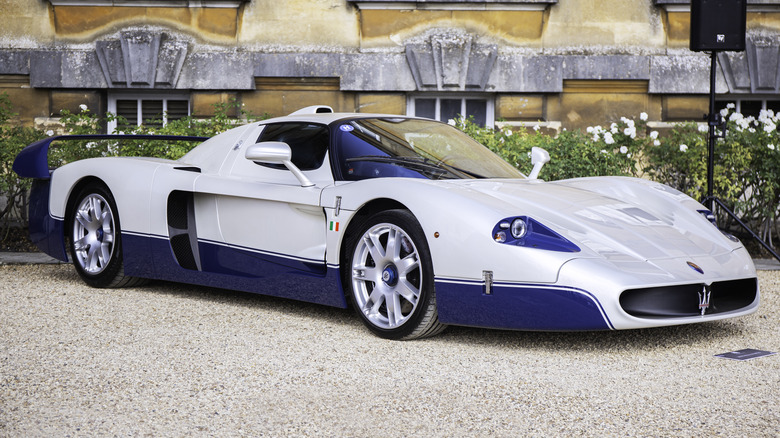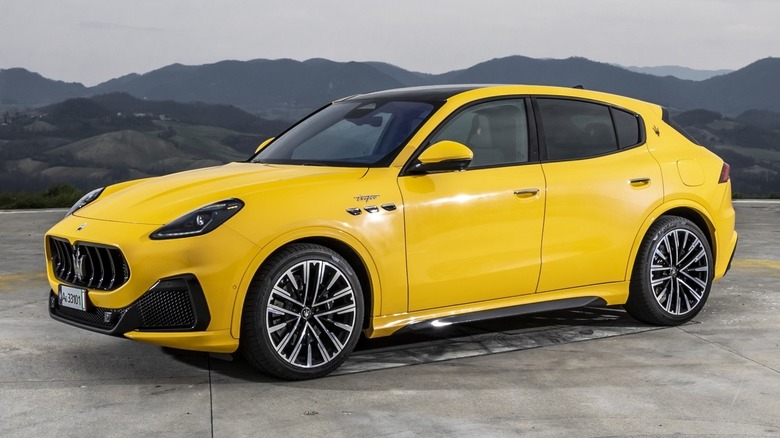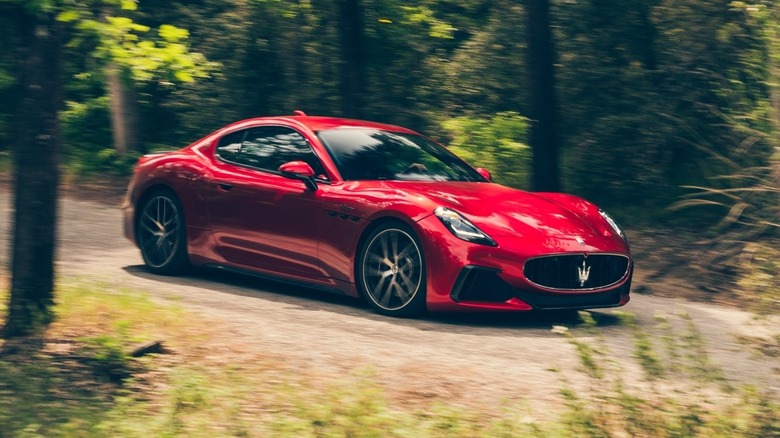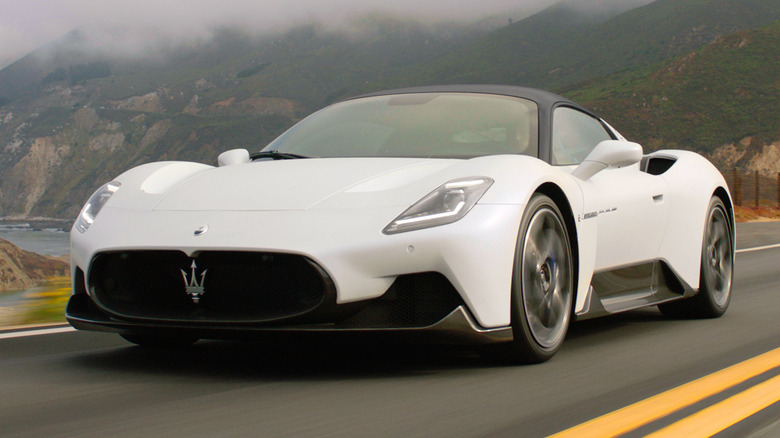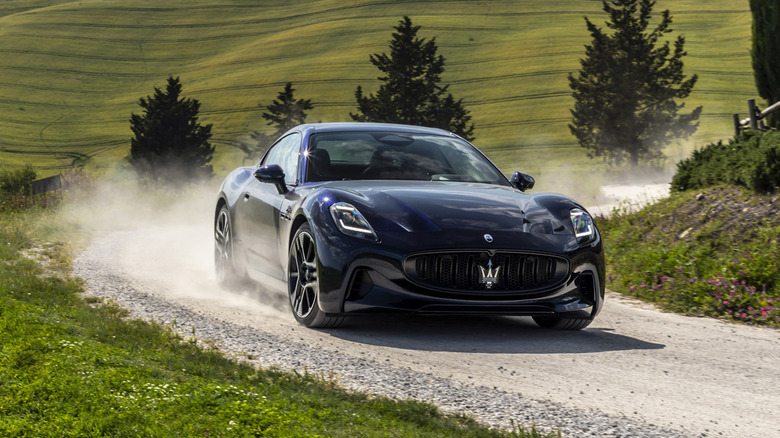10 Of The Fastest Maseratis Ever Built, Ranked
In a history spanning over 100 years, Maserati has been responsible for Italy's most famous performance cars, both for racing and for the road. It was one of the first foreign brands to prove its worth at the top level of racing in America, with Wilbur Shaw winning the Indy 500 in both 1939 and 1940 in an 8CTF. Over the decades, the brand has been through a series of buyouts and bankruptcies, and has produced some not-so-great cars along the way. In 2021, it became a subsidiary of European conglomerate Stellantis, which has put considerable investment into overhauling Maserati's lineup with a slew of updated models.
In recent years, the brand has also refocused on its historical reputation as a leading performance manufacturer, and today, every model in its lineup has a range-topping performance variant. As a result, many of its fastest cars are those currently in dealerships. A handful are even faster than the legendary Enzo-based MC12. Maserati is in the process of transitioning to an all-electrified lineup over the next few years, so even speedier variants of the brand's current models will likely break cover in the near future.
Here are 10 of the fastest Maseratis ever made, ranked by how fast they reach 60 mph from a standstill.
Maserati Spyder – 4.9 seconds
The first model to return to America after a lengthy absence, the Spyder was thoroughly re-engineered thanks to investment from Maserati's then-owner, Ferrari. It debuted in 2002 and sported similar styling to the Europe-only 3200 GT, but underneath there were few similarities between the two cars. The Spyder boasted a 4.2-liter naturally-aspirated V8 engine making 385 horsepower, and an officially quoted 0-60 mph time of 4.9 seconds.
That put it less than half a second slower than the Ferrari 360 Spider off the line. The car was available with either a six-speed manual or a six-speed paddle-shift automatic, and it was the latter that delivered the fastest performance. Maserati noted at the time that it was twice as quick to shift as its best factory test driver. The engine's redline arrived at 7,600 rpm, but peak torque of 333 lb-ft came at 4,500 rpm. Combine that with the ItalDesign-penned styling, and the result was a car worthy of announcing Maserati's return to America.
Maserati GranTurismo MC Stradale – 4.6 seconds
The racing-oriented version of Maserati's GranTurismo grand tourer gained ten horses and lost its rear seats, cutting weight down and making it even faster than the standard car. Its 0-60 mph time was reduced to 4.6 seconds, while its top speed was increased to 187 mph. It wasn't just a track day toy, though. Despite its weight-saving diet, the car's interior still featured the luxurious Alcantara upholstery buyers expected from a six-figure vehicle. Albeit, the seats themselves are constructed of carbon fiber.
The MC Stradale was an upgrade for enthusiasts looking for the most precise handling, but it came at a steep price increase over its touring-focused counterpart. In fact, it was more than three times as expensive. It also wasn't quite as fast as rivals from Ferrari or Porsche, even if it was one of Maserati's fastest cars ever made at the time.
Maserati Quattroporte Trofeo – 4.2 seconds
The Quattroporte Trofeo is the current top-spec variant of the brand's flagship four-door sedan, and it launched for the 2021 model year. The Trofeo badge denotes Maserati's most performance-focused models, and as such, it is featured on many of their fastest-accelerating cars. The Quattroporte is the least rapid of the current crop of Trofeo-badged cars, with an officially quoted 0-60 mph time of 4.2 seconds.
Under the hood sits a 3.8-liter V8 making 572 horsepower and 524 lb-ft of torque, which helps propel the car to a top speed of 203 mph. All that power is sent to the rear wheels through an eight-speed automatic transmission.
The current Quattroporte Trofeo will likely be the last of its kind, as Maserati's impending switch to a fully electrified lineup leaves no room for the traditional, Ferrari-derived V8 on offer in the 2023 car. Whether that's worth a starting price north of $150,000 will be up to buyers to decide, but make no mistake: this may be the swansong for the V8 Quattroporte, but it isn't going out quietly.
Maserati Ghibli Trofeo – 4.0 seconds
Serving as an entry point into Maserati's range, the Ghibli is the sedan for those who haven't yet made the step up to the Quattroporte. It is, however, slightly faster off the line in Trofeo form, with an official 0-60 mph time of four seconds flat. We drove the car around Willow Springs at launch and were impressed with how confidently the Ghibli Trofeo handled, with the automatic transmission always leaving the car in its optimum power band despite our best efforts to unsettle it.
We also thought the car's interior lived up to its luxury rivals, with the overhauled infotainment and added connectivity features making the car a more appealing proposition to live with every day. A car like this does need to be liveable. Despite its track-ready credentials, a four-door sedan is never going to be anyone's first choice for apex hunting, and indeed many owners won't ever drive the car at its limits.
The question with the Ghibli Trofeo, much like the Quattroporte Trofeo, is whether its $120,000-plus price tag makes it a worthwhile purchase. A base-spec Ghibli isn't slow, and at around $40,000 less than the top-spec variant, buyers will have plenty of cash left over to put towards a dedicated track toy if they're that way inclined. However, for anyone who simply has to have the fastest Ghibli variant that Maserati has to offer, the Trofeo can't be beaten.
Maserati Levante Trofeo – 3.8 seconds
Much like its Trofeo-branded sedan stablemates, the Levante Trofeo utilizes Maserati's 3.8-liter twin-turbo V8 engine. However, it's slightly quicker to 60 mph than either of them, taking just 3.8 seconds to get there from a standstill. Top speed, however, is down to 187 mph. The front-end styling similarities between all three models are clear, but the higher roofline at the rear of the Levante makes it a more appealing proposition for hauling a family. Well, in theory at least – in practice, we found the interior to be a little less spacious than the segment benchmark Porsche Cayenne, both in terms of cargo capacity and rear legroom.
The Levante Trofeo is also not the comfiest SUV to drive day-to-day, as its firm suspension serves to offset body roll at higher speeds, but leaves little capacity to absorb bumps on rougher roads. Again, other performance SUVs do a better job of balancing track-day capability and everyday comfort. However, where the Maserati comes into its own is its soundtrack. The engine is built in Ferrari's factory, and boasts a roar worthy of a Prancing Horse too. Much like its stablemates, it comes at a cost: it starts at just over $160,000, but options can add a significant amount to that total.
Maserati MC12 – 3.8 seconds
Sandwiched between Maserati's top current models in the speed rankings is one of the brand's greatest cars of all time, and a product of its Ferrari ownership that served as a halo car until the unveiling of the MC20. The car in question is the MC12, an ultra-limited hypercar based on the Ferrari Enzo that first broke cover in 2004. The MC12 was mechanically closely related to the Enzo, sharing its V12 engine, but is the rarer of the two cars, with just 50 road-going examples built.
Exactly how fast the car is off the line is hard to verify. Officially, it was claimed to take 3.8 seconds, but MotorTrend clocked a 3.7-second best during testing and others have claimed to shave a few tenths more off that figure. In the Maserati, the V12 engine was tuned to produce more than 620 horsepower, with a redline at 7,500 rpm. Notably, that's slightly short of the 651 horsepower available in the Enzo.
The MC12 was first developed as a way to meet homologation requirements, so the brand could enter GT1 racing. However, it's since become an icon of the brand, and a symbol of the rapid transformation at the turn of the century that took Maserati from a struggling, noncompetitive carmaker to one of the world's most desirable performance car brands.
Maserati Grecale Trofeo – 3.6 seconds
A smaller, cheaper, and nimbler alternative to the Levante, the Grecale is the brand's newest production car. We drove it at launch and found it to deliver everything buyers would expect from an SUV in its segment — performance, technology, and a better interior than even some pricier models in Maserati's lineup. However, it wasn't without its flaws. In particular, our tester thought the car's handling was limited by its chassis, especially when driving the top-spec Grecale Trofeo at higher speeds.
That was a shame considering the Trofeo's entire appeal centers around that additional performance. On paper, it's a big boost over lower trims, with its MC20-derived V6 engine churning out 523 horsepower and propelling the car to a top speed of 177 mph. The sprint to 60 mph takes just 3.6 seconds, pushing the Grecale Trofeo marginally ahead of its bigger brother, the Levante Trofeo. On the road, however, our tester found it tricky to make the most of the extra power on offer.
It's not perfect then, but the Grecale Trofeo still offers a compelling alternative to the likes of the Porsche Macan. Its Italian heritage is no marketing tool — the car is built in Italy — and its luxury credentials rival the best in the segment. Then again, one would hope so in a car that starts at $105,500.
Maserati GranTurismo Trofeo – 3.3 seconds
Five years after the first generation GranTurismo was retired in 2019, the new generation was launched for the 2024 model year. This second incarnation is available in both combustion and electric forms, with the top-spec gas-powered GranTurismo being the Trofeo. We drove both the Trofeo and entry-level Modena in Italy earlier in 2023 and found that, ironically, it was the Modena that felt the better-balanced car. That's despite both trims being mechanically identical bar an upgraded ECU.
The Trofeo, with its V6 engine churning out 542 horsepower, lost grip more easily, therefore inspiring less confidence coming into corners. However, the added power does make it the fastest gas-powered variant in a straight line, with a 0-60 mph time of 3.3 seconds.
Upon stepping inside the car, drivers are treated with a cabin that's typical Maserati fare: plush upholstery, comfortable seats, and plenty of room. Happily, the infotainment tech is one of the brand's best efforts too, with none of the outdated features that plagued the first-generation car. It's all around an impressive return for the Trident brand's signature grand tourer, but at a $205,000 starting price, it faces some stiff competition from its many European rivals.
Maserati MC20 – 2.9 seconds
The MC20 marks Maserati's triumphant return to supercar making, boasting not only unprecedented performance for a gas-powered Maserati but also a strikingly good-looking design. Our first drive of the car in 2022 confirmed a few things. Firstly, it's fast; very fast, even to the point where license-losing speeds are only ever a short stab of the throttle away. That power comes courtesy of a specially developed V6 engine, which is good for 621 horsepower. That's almost identical to the output of the MC12 hypercar, of which the MC20 became the spiritual successor.
Reaching 60 mph from stationary takes less than 2.9 seconds, and the car will keep pushing to a top speed of 202 mph. Despite its performance chops, the MC20 doesn't lose sight of what matters most: how it feels to drive. We thought its handling was particularly commendable, with a variety of modes and driver assists available to suit everyone from supercar novices to seasoned track day veterans. It's a car that's not only good at going fast, but one that makes its driver look good doing it. As a result, is worthy of its place at the very top of the Maserati tree.
Maserati GranTurismo Folgore – 2.7 seconds
Although the MC20 is the brand's current halo car, it's not currently the fastest car the brand offers, at least not off the line. That crown instead goes to the GranTurismo Folgore, which hits 60 mph in just 2.7 seconds thanks to its three electric motors. It generates 760 horsepower and 996 lb-ft of torque, although the wintry conditions of our test drive meant we couldn't put all those horses to full use. The Folgore uses the same chassis as the gas-powered GranTurismo, with its battery located where the engine usually sits in the combustion car.
A similar strategy is set to be used by the upcoming MC20 Folgore: rather than develop a specific all-electric chassis, the MC20 was designed to accommodate both gas and electric powertrains from the outset. For now, Maserati has remained tight-lipped on the performance capabilities of the electric halo car, but it's safe to assume that it will boast superior figures to that of the GranTurismo Folgore. It seems that Maserati will soon have an even faster car on offer, but for now, the electric GranTurismo remains the quickest car the brand has ever made.

